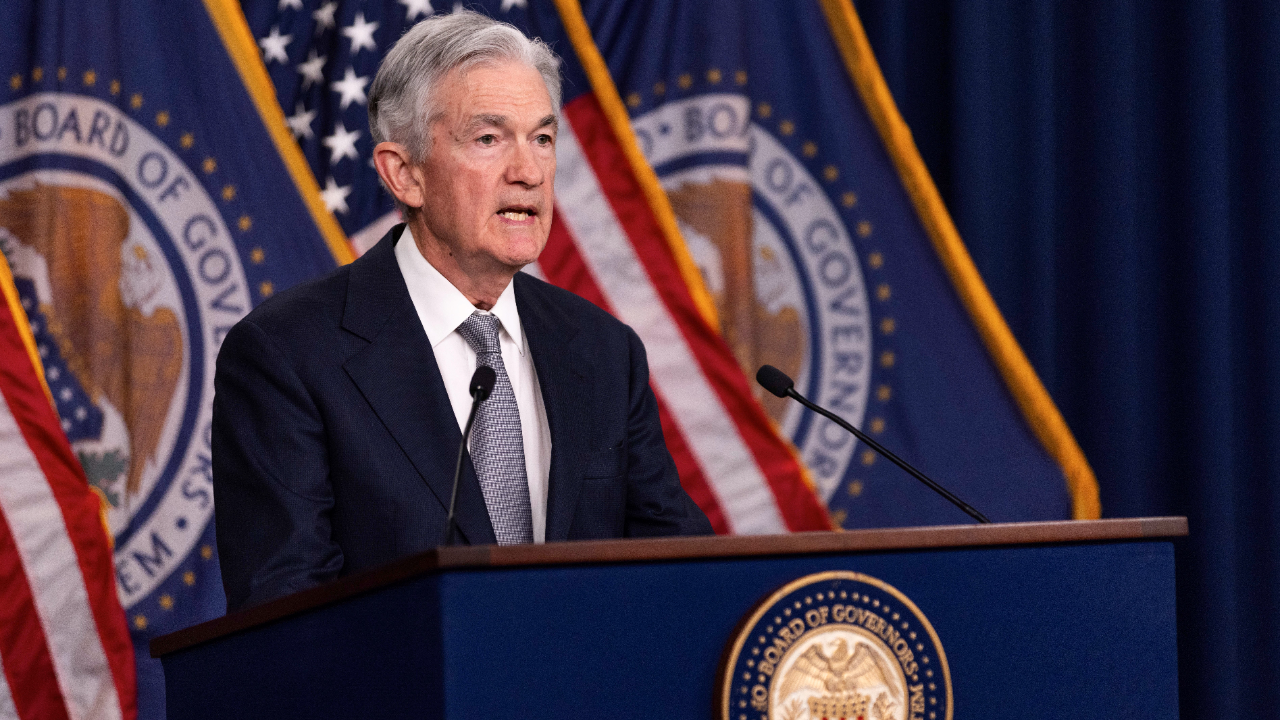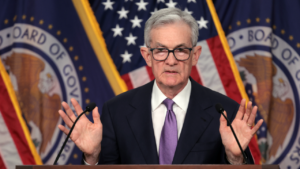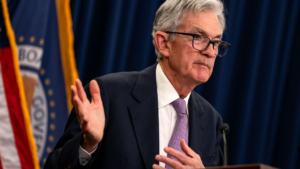Trump’s tariffs are raising fears of a recession. What can the Fed do about it?

When the Federal Reserve first started aggressively lifting interest rates to battle red-hot post-pandemic inflation, many consumers and investors started to ponder the extent of the U.S. central bank’s resolve. Would Fed officials be willing to stifle economic growth, even if it risked a recession?
Three years later, we could be on the verge of learning the answer.
Officials on the Federal Open Market Committee (FOMC) look poised to keep interest rates unchanged when they announce their next interest rate decision today, but they’ll likely stress that the economic outlook is uncertain, thanks to tariffs, federal layoffs, stricter immigration and more from President Donald Trump’s new administration.
Federal Reserve Chair Jerome Powell’s words will be closely parsed amid one of the sharpest — and swiftest — stock market sell-offs in years. Americans’ investment accounts have been getting pummeled amid Trump’s stop-and-go tariff hikes, with the S&P 500 dropping more than 8 percent from its all-time high on Feb. 19. The tech-focused Nasdaq Composite Index plunged 4 percent alone on March 10, its worst day of trading since 2022.
The last time Americans heard from the chief central banker, he said that the U.S. central bank was in a solid place and can afford to be patient as they wait to see how the economy responds.
“Despite elevated levels of uncertainty, the U.S. economy continues to be in a good place,” Powell said at an event hosted by the University of Chicago on March 7. “We do not need to be in a hurry and are well positioned to wait for greater clarity.”
Yet, the ultimate question is what Fed officials should do to maintain their twin goals of maximum employment and stable prices in an environment where tariffs could put both in jeopardy, according to economists. Tariffs could push up prices at a time when price pressures remain elevated. They also risk weighing on economic growth as businesses reroute their supply chains or pause hiring and investing decisions.
In a Fox News interview earlier in March, Trump didn’t deny that his policies could spark a recession and urged Americans to brace for a “period of transition.” The Trump administration has also signaled that it may press ahead with new tariffs even if they weaken the economy.
What do threats of weaker growth and higher inflation mean for the Fed’s next moves? Here are the biggest questions facing the U.S. central bank as it decides what to do with the interest rates that influence how much you pay to borrow money.
Inflation is the type of thing that would keep the Fed on the sidelines, but a sharp slowdown in growth, or a rapid deterioration of the labor market, could prompt the Fed to resume cutting rates.— Greg McBride, CFA, Bankrate chief financial analyst
Save the economy from a slowdown or keep inflation in check? Fed officials could be forced to ‘choose one over the other’
Typically, higher prices and a slower economy are counterintuitive. Inflation usually indicates that the financial system is red-hot, a symptom of wage hikes or too much money chasing too few goods — similar to what happened during the pandemic.
They also both require something different from the Fed. The U.S. central bank slashes the price of borrowing money when the financial system might be losing steam and raises interest rates when they want to cool the economy.
The rare combination, however, has happened before: in the 1970s and early ‘80s. Back then, prices soared almost twice as high as they did during the post-pandemic era, while the Fed intentionally inflicted a devastating U.S. recession — at the time, the worst since the Great Depression — to bring price pressures back down. Economists have a term for it that’s become a dirty word for the Americans who lived through it: stagflation.
“The combination of policies that we are seeing right now has a real risk of bringing that on,” says Erica Groshen, senior economic advisor at the Cornell University School of Industrial and Labor Relations, who was the former commissioner of the U.S. Bureau of Labor Statistics and vice president of research at the Federal Reserve Bank of New York.
Even St. Louis Fed President Alberto Musalem, who has a vote on interest rates this year, said in public remarks on Feb. 20 that a scenario where inflation rises at the same time the labor market weakens “must also be considered.”
In those circumstances, the Fed’s choices — rescuing the labor market or focusing on inflation — aren’t easy.
If they're in that situation, they're going to essentially have to choose one over the other. I suspect they will say it will be very costly to bring inflation down if we let it get very high. Therefore, in order to prevent us from having to do more damage in the future, we'll lean toward making sure that inflation doesn't get out of hand.— Erica Groshen, senior economic advisor at the Cornell University School of Industrial and Labor Relations
The case for cutting interest rates
Even as forecasts suggest Trump’s tariffs could lift prices, though, investors have upped their projections for rate cuts this year. They’re currently expecting that the U.S. central bank will reduce borrowing costs by half a percentage point in 2025, moves that would bring the Fed’s key borrowing benchmark to 3.75-4 percent, according to CME Group’s FedWatch tool. The 30-year fixed mortgage rate has already plummeted as Treasury yields reflect the possibility of lower rates, according to Bankrate’s weekly survey of interest rates.
Tariffs could weigh on economic growth because they often lead to supply shortages, as companies attempt to reroute their supply changes. They also make production more expensive, weakening company profitability.
Case in point: The Fed reduced borrowing costs three times in 2019, in part because Trump’s smaller-scale, first-term trade war injected a new layer of uncertainty about the pace of future economic growth.
Even if Trump stands down on some of his toughest tariff hikes, some damage might already be done, according to Mike Skordeles, head of U.S. economics at Truist. Unsure of what the future may hold, Skordeles’ business contacts have been telling him that they’re hesitant to make new investments or hire more workers right now.
“When they don’t know from day to day whether this tariff is being delayed or that one is definitely going to happen, tomorrow it gets delayed again, it causes a lot of uncertainty, much like for the Fed,” Skordeles says. “Businesses say, ‘I might as well sit and wait.’ Sitting and waiting is not pro-growth.”
One indication of extra uncertainty: Businesses stockpiling on imports to get ahead of tariffs caused a key model predicting economic growth from the Federal Reserve Bank of Atlanta to plunge in late February.
Another reason to err on the side of rescuing the economy, federal layoffs — which hit almost 63,000 last month, according to the latest data from Challenger, Gray & Christmas — could lead to job losses in the private sector, Groshen says. That could also weigh on consumer spending, keeping downward pressure on inflation, too.
“It can affect whole neighborhoods where you have concentrations of government workers,” Groshen says. “Some of the laid-off people are going to find other jobs quickly and others won’t.”
The case for leaving rates alone — or even increasing them
Typically, economists say tariff hikes are a one-time price increase — not an inflationary spiral. Trump’s 25 percent tariffs on goods from Canada and Mexico, as well as 20% tariffs on goods from China, could increase price levels by 1-1.2 percent, translating to an average cost per household of $1,600 and $2,000, according to the Yale Budget Lab’s latest estimates.
“A tariff-induced bump in inflation, which is at the root of the concern for consumers and businesses, isn’t by itself going to produce the type of trend that the Fed is most concerned about,” McBride says. “It probably does more to slow growth than it does to contribute to persistent acceleration of inflation pressures.”
Even so, Fed officials might find it troubling if tariffs become ingrained in the psychology of investors and everyday people. Guided by their experiences in the ‘70s and ’80s, Fed Chair Jerome Powell & Co. prescribe to an economic theory that expectations of sharper inflation can often become a self-fulfilling prophecy.
Consumers’ inflation expectations in March rose the most since 1993 as Americans faced higher prices and braced for tariffs, according to the University of Michigan’s preliminary consumer sentiment survey for the month.
Meanwhile, a tit-for-tat trade war with consistent import tax hikes could lead to more price hikes, researchers at the Yale Budget Lab concluded.
For now, though, Powell in March appeared to hint at another policy path as officials await for more clarity in the data: Leaving interest rates higher for longer.
That itself could slow the economy, according to Groshen. Interest rates are more than a percentage point above policymakers’ current estimates of the so-called “neutral” level of interest, or the rate at which interest rates neither speed up nor slow down the economy.
“Let’s say that the economy shows every sign of dipping into a recession,” Groshen says. “Without the inflationary pressures, the Fed would probably act very quickly to reduce rates. With the inflationary pressures, they would probably wait a little bit longer. … It’s only after the fact that you’ll know they were too high for too long.”
What to do with your money as the Fed’s next moves look uncertain
The Fed no doubt plays a role in influencing all of your financial decisions, big or small. Planning your goals when you’re unaware of how pricey financing costs may be down the line can feel impossible. Experts, however, say that your financial goals and objectives shouldn’t change based on headlines alone.
- Pay down high-interest debt: Credit card debt is costly even when the Fed’s key interest rate is low. If you’re carrying a balance, eliminating your credit card debt can free up cash that you might be able to use for other financial goals, such as saving for emergencies or retirement. Consider utilizing a balance-transfer card with a 0 percent introductory annual percentage rate (APR) to help speed up your repayments.
- Mortgage rates have fallen: After staying stuck above 7 percent for two months, the 30-year fixed-rate mortgage has finally started to retreat — though it’s still higher than at any point during the coronavirus pandemic. Prospective homebuyers have been waiting for this moment, even if it reflects fears of a slowdown more so than the prospect of cooling inflation. There’s no sense in timing the market, though, McBride says. If you have the funds to buy a house now and can find something in your budget, there’s little reason to wait.
- Don’t fear a stock market correction: Americans were blessed with a booming stock market in 2023 and 2024. They might’ve forgotten just how painful stock market volatility can feel. Remember: Selling when stocks are in the red is the only way to lock in a loss. If you’re diversified and are investing for the long haul, you can afford to tune out the noise and wait out the volatility, McBride says.
- Continue saving, and you’ll keep being rewarded: Periods of economic uncertainty underscore the importance of building up your emergency fund. And with interest rates still high, savers have the benefit of the most competitive yields in over a decade, assuming they’re parking their cash in a high-yield savings account.
“A lot of Americans are undersaved for emergencies or for retirement and struggling with high-cost debt,” McBride says. “That’s something to work on when the times are good or the times are tough, and whether the outlook is rosy and whether the outlook is bleak.”
You may also like

How the Federal Reserve impacts savings account interest rates

Fed keeps interest rates unchanged, sees cuts coming in 2024

Fed lowers interest rates with surprising jumbo half-point cut



